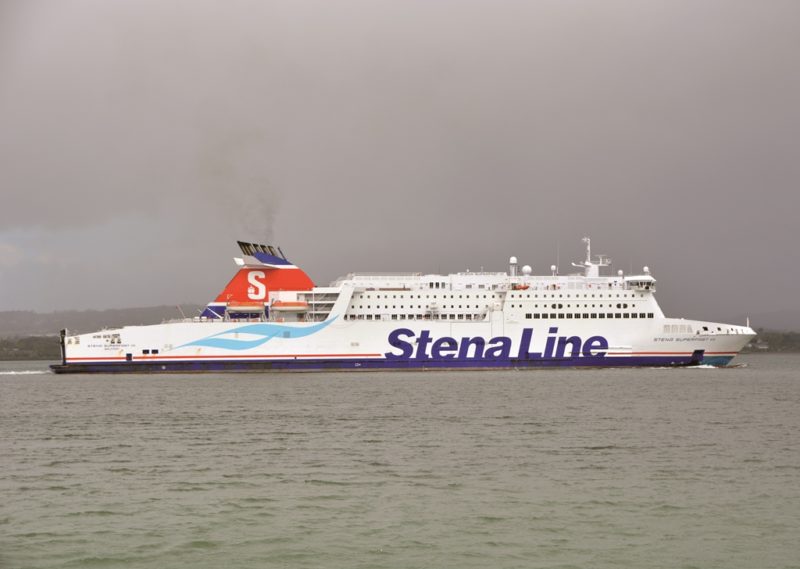
THE STENA LINE REPORT OF 1995
The Stena Group annual report of 1995 showed there was a total of 8,470 seafarers and shore based staff, with a total group operating income of 9.436 million Swedish kronor, and with the English Channel and Harwich to Hook of Holland routes contributing 40%, the Irish Sea routes 28%, the Kattegat routes 27%, and the Skaggerak route only 5% of the total income. There were a total of fifteen routes operated, and used by 15 million passengers, 2.7 million cars, and 930,000 trucks, trailers, containers and railway locomotives and carriages. The Group income was generated by ticket sales of the ferries, onboard food, freight income, and the arrival, departure and other charges of the four owned ports of Harwich, Fishguard, Holyhead and Stranraer.
Dan Sten Olsson was Chairman of the Group with a dozen other members of the Board, including six employee Trades Union representatives appointed from Swedish Trades Unions to protect the employment rights of crews and staff. Gareth Cooper was Managing Director of Stena Line (U.K.) Ltd. The current Board in 2021 also has a dozen members with Gunnar Brock as Chairman, Dan Sten Olsson as CEO, and including three Trades Union representatives appointed from Swedish Trades Unions to protect the employment rights of crews and staff. Sweden has had a stable Social Democratic Government since 1932, with a legal requirement by an Employment Act of 1973 for worker representatives on Boards of all companies, banks, mortgage and insurance institutions, and co-operatives with a minimum of 25 employees. Sweden also has a highly advanced system of social security.
In 1995 the company operated a fleet of 35 feries.
Seventeen of these ferries were long term leased or chartered. Rosebay had been built by J. J. Sietas at Hamburg as Transgermania for Poseidon Schiffarts OHG, and was chartered by Stena in 1983 and renamed Rosebay for service between Harwich and Rotterdam, and was then transferred to a Harwich to Hook of Holland service in July 1995, remaining until October 2000.
Stena Searider was built in 1969 as Finncarrier for Finnlines services in the Baltic, and after further service for other owners in the Baltic she was purchased by Stena Line in 1990 and renamed Stena Searider for service between Gothenburg and Travemunde. She served on the Harwich to Hook of Holland service between 1995 and 2007. She is still in service as Claudia M in the Mediterranean on a Gaeta to Trapani and Tunis route.
Stena Scanrail was fitted with embedded rail lines on her vehicle deck but has not always loaded railway wagons. She was built in 1973 by A. Vuyk & Zonens in Holland and became Stena Scanrail during the period from 1987 to 2015. She is still in service as Birdeniz on a Ambali to Gemlik route in Turkey.
Stena Seatrader was built for Lion Ferry in 1973 as Svealand for the Trelleborg to Sassnitz route, and was lengthened at Hamburg in 1982 and given accommodation for one hundred lorry drivers. She served on the Harwich to Hook of Holland route as Stena Seatrader between 1990 and 2008, when she was sold to Ventouris Ferries of Greece and renamed Seatrader.
Three of these above routes were operated in 1996/97 by high speed HSS 1500 catamarans, carrying both passengers and cars. The first HSS 1500 ferry was presented for inspection to the Stena staff, international press and the general public on 16th February 1996 at Lysekil on the west coast of Sweden after delivery from Finnyards at Rauma. She then proceeded down the coast to Gothenburg where she was again opened to the general public. The ports of Holyhead and Dun Laoghaire on the Irish side were completely rebuilt to take their HSS 1500, Stena Explorer. Holyhead gained a new entry to the port at Salt Island, with a bridge linking the eastern and western sections of the port. This meant that the traffic was led directly to the ferries without causing congestion through the centre of the town.
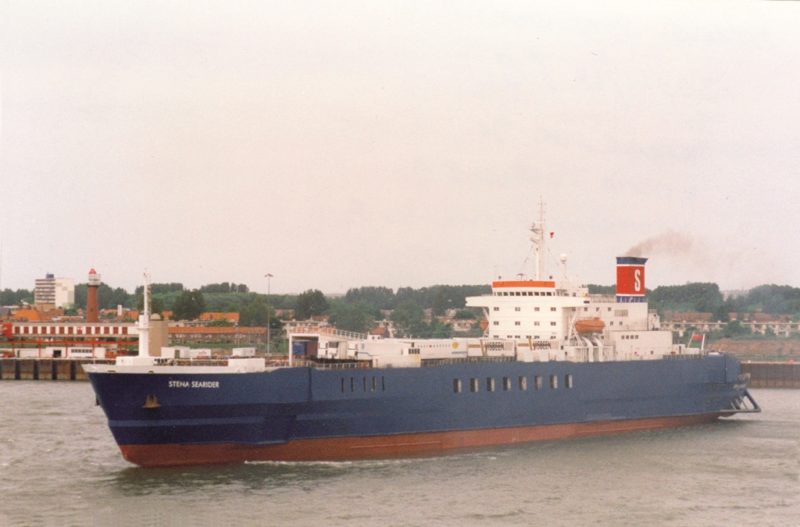
Stena Discovery was the Harwich to Hook HSS 1500 fast craft, and when she entered service, both Koningin Beatrix and Stena Britannica (2) were transferred to other routes, leaving the HSS 1500 with no backup when her twice daily service was cancelled due to bad weather. Fast craft are much more prone to cancellations than the superior heavy weather ability of large Ro-paxes. The decision by Stena Line to introduce the HSS 1500 fast ferry on the Harwich-Hook route prompted a £12 million redevelopment project at Harwich, which included a dedicated berth and linkspan for Stena Discovery and major shoreside improvements upstream from the original port. Stena Discovery berthed on the outside of the big Ro-pax berth next to the quay.
The new Stena Jutlandica (3) of 29,691 grt in 1996 was the first ferry in the world to be fitted with catalytic converters on all of its engines to reduce sulphur and other emissions by 90% when she began in June 1996 on the Gothenburg to Frederikshavn route. She had been launched on 2nd March 1996 at the Krimpen yard of Van der Giessen du Nord in the Netherlands, and had dimensions of length 182.35 metres, moulded beam of 28.43 metres, and a loaded draft of 6.0 metres. She has accommodation for 1,500 passengers and 550 cars on her car deck of lane length 2,100 metres. She has a service speed of 21.5 knots from four M.A.N.-B & W diesel engines, and is still in service with Stena Line today.
In 1995/97, all of the Stena ferry fleet adopted the now familiar funnel livery of a central white ‘S’ on a broad red band between two narrow white bands, and with a blue top and bottom. This included the subsidiaries of Lion Ferry and Stena (U.K.) Ltd., with all of the Stena fleet then simply marketed as Stena Line. The Stena Bulk A/B tanker fleet had always had a black top and base to their funnel colours, and only in recent years have they been given a blue top with a black base.
Stena Challenger ran aground outside Calais on 19th September 1995 in a bad storm but was refloated during the next day. She had suffered extensive bottom damage, and was towed from Dunkirk on 28th September to the Tyne to have 220 tonnes of steel replaced forward of the engine room bulkhead. She returned to Dover to Calais service on 24th October 1995, having become the first Stena Line ship to be repainted in the new fleet livery. She had been launched at Landskrona on 6th October 1990, and had been towed to Fosens Mek Verksted for fitting out and delivery.
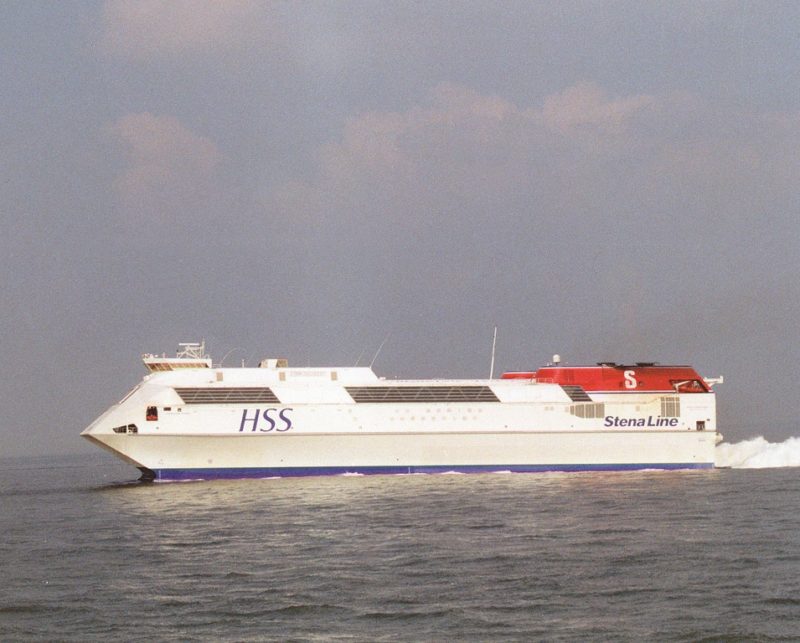
Four new twin funnelled and large Ro-paxes were ordered from Astilleros Espanoles of Spain for delivery during 1999/2001, with the first pair becoming Finnclipper and Finneagle for Finnlines, with the third ferry completed as Stena Britannica (3), but she had only a short three year career on the Harwich to Hook of Holland route before her sale in 2003 to Finnlines to become their Finnfellow. The fourth and final sister, Stena Hollandica of 2001, in contrast continued on the Harwich to Hook of Holland until replaced by a much larger vessel of the same name in 2010.
This quartet of big Ro-paxes had accommodation for 452 passengers, with the freight deck having capacity for many trailers or trucks and 360 cars, and a service speed of 21.5 knots. The fast craft HSS 1500 Stena Discovery was withdrawn from service in January 2007, and Stena Hollandica was then stretched by a midships 52 metre section at Bremerhaven to cope with the extra traffic. A new twin funnelled Stena Britannica (4) of 43,387 grt with accommodation for 900 passengers and a lane length of 3,400 metres had arrived from the Hyundai Heavy Industries yard in South Korea in 2003 to run on the service with Stena Hollandica until both were replaced by much larger ferries in 2010. After the abolition of tax free shopping within the European Union in 1999, the emphasis of Stena Line began to shift more towards freight carrying, and several ships lost cabins in favour of more freight carrying ability.
The trio of twin funnelled freight carriers known as the ‘Forerunner Mark III’ class were ordered in 1999 from a yard at Dalian in China of 24,688 grt and lane lengths on their vehicle decks of 3,000 metres. They have dimensions of overall length of 195.3 metres, moulded beam of 25.6 metres, and a loaded draft of 6.6 metres. They have high service speeds of 22.5 knots when all four eight cylinder Wartsila Sulzer 8ZAL40S diesel engines are in use. The first of the class to be delivered was Stena Foreteller in 2002, second was Stena Forecaster in 2003, and third and last was Stena Forerunner later in 2003. They have been chartered out to many shipping and freight companies including Transfennica, Cetam Massalia, Oceanex, StoraEnso, DFDS, Irish Ferries, Cotunav of Tunisia, and Airbus for the carriage of aircraft wings and fuselages.
Two Sunderland built ‘Superflex’ ferries, out of fifteen sisters that were built just before shipbuilding ceased forever on the Wear in 1988, and owned by the Mercandia Shipping of Per Henriksen were purchased by the Stena Group in 2001 as the HH-Ferries Line of Sweden. This pair had blue hulls with red boot topping, and red ‘HH Ferries’ on their white superstructures. They ran on a route from Helsingborg in Sweden to Helsingor in Denmark, a service that had started in 1996.
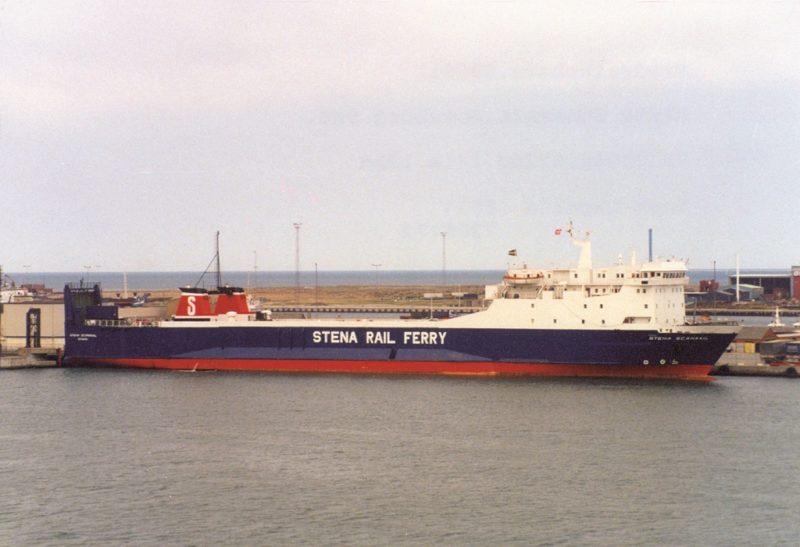
THE STENA RO-PAX and FREIGHT RO-RO FLEET IN 2005
A large fleet of 35 ro-paxes and ro-ros were managed from the Gothenburg, Hook of Holland and Ashford in Kent offices of the Swedish, Dutch and British fleets of Stena. Five of these were Scandlines ferries owned by Stena Line Scandinavia A/B of Sweden and operated from the Helsingborg (Sweden) office on services Helsingborg (Sweden) to Helsingor (Denmark), Trelleborg (Sweden) to Rostock (Germany), Trelleborg (Sweden) to Sassnitz (Germany), and Trelleborg (Sweden) to Travemunde (Germany). The Swedish part of the big ferry operator on the Baltic, Scandlines A/B, had been acquired during 2005 to end a long spree of Stena Line acquisitions. However, the big Scandlines A.G. ferry fleet remained German owned and operated. The Cairnryan to Larne Ro-pax ferry European Ambassador, built in 2001, of P. & O. Ferries was purchased in 2004 and renamed Stena Nordica for the Karlskrona to Gdynia service.
The fleet in 2005 consisted of both owned and chartered Ro-Paxes and freight Ro-Ros.
The twin funnelled ‘Forerunner Mark III’ class of Stena Forecaster, Stena Foreteller and Stena Forerunner were all chartered out to Transfennica in 2005. Two Cobelfret Ferries ro-ro sisters, Severine and Capucine of 16,432 grt, built at the Kyokuyo yard at Shimonoseki in Japan in 2011/12 were chartered for four years by Stena for the Harwich to Rotterdam route in September 2012 and January 2012 respectively. They have overall lengths of 152.0 metres, freight lane lengths of 1,760 metres, and good service speeds of 17.5 knots. They were replaced in January 2016 by the 150 trailer freight ferries Misada and Misina on this route.
The Killingholme Humber Sea Terminal used by Stena Seatrader and Stena Searider has six berths, with Phase 1 opened in June 2000 by Stena Line for their service to the Hook of Holland, followed by Phase 2 in February 2004 and Phase 3 in 2007. As well as Stena Line, the terminal is also used by Cobelfret, UECC and Eukor ro-ros.
The Gothenburg to Travemunde route was operated by two sister twin funnelled ro-ros in Stena Carrier and Stena Freighter of 21,089 grt with dimensions of overall length 182.8 metres, moulded beam of 25.5 metres, and a loaded draft of 9.4 metres, with four Sulzer 8ZA40S diesel engines giving a high service speed of 22.0 knots. They have freight lane lengths of 2,715 metres and accommodation for a dozen drivers. They had been built by an Italian yard in Apuania ‘on spec’ for the State owned Societa Finanziaria srl, and had another sister in the Stena Line fleet in Stena Forwarder renamed Ark Forwarder on the Harwich to Hook of Holland and Rotterdam route. The ‘ARK’ project was a military co-operation project established in 2003 by the Danish and German Ministries of Defence for the provision of ro-ro tonnage. Ark Forwarder had been completed in 1998 as Sea Centurion for a five year charter to the Ministry of Defence (U.K.) for the carriage of tanks and heavy military equipment. The ‘ARK’ ro-ros have also seen service in the troubled war zones of the Eastern Mediterranean, the Persian Gulf and elsewhere in the world.
In November 2006, Stena Line ordered a pair of ‘Super Ferries’ at a combined cost of E400 million with a gross tonnage of 63,600 from Aker Wadan Yards at Wismar in Germany for delivery in 2010, with an option for two more ships of this huge size of the same design. This pair of Stena Britannica (5) and Stena Hollandica (2) are among the largest Ro-Paxes in the world and run on the Southern North Sea route from Harwich to the Hook of Holland. The existing ships on this route were moved to the Gothenburg to Kiel route, and the displaced Kiel ships moved to the Karlskrona to Gydnia route. Stena Hollandica (2) entered service on 16th May 2010, while her sister Stena Britannica (5) entered service on 9th October 2010. The order for the two giant Ro-paxes had been in jeopardy when Stena temporarily withdrew the order due to delays at the yard, and the order was only reinstated when a reasonable discount had been negotiated for the delays.
This pair of giant Ro-pax ferries have 538 cabins for 1,376 berthed passengers as well as 1,200 passengers in aircraft style seats accommodation, with a vehicle deck of 5,500 lane metres for mixed trucks and cars. They are huge ships with a dozen passenger and vehicle decks, and are Ice Classed 1BFS on dimensions of overall length 240.0 metres, moulded beam of 32.0 metres, moulded depth of 51.0 metres, with a loaded draft of 6.65 metres. Propulsion is via a quartet of four stroke M.A.N. diesel engines giving a fast service speed of 22 knots. A crew of 85 includes stewards for the various onboard restaurants and bars. Stena Britannica (5) suffered a small but potentially dangerous fire on 17th January 2018 on one of the refrigerated lorries being carried, which subsequently spread to other trucks, but did not breach the integrity of the sprinkler system or the safety of the vessel. The ferry was out of service for three days while the decks were being checked over at Schiedam Dry Docks.
Stena Line introduced two new freight Ro-paxes on to the Killingholme to Hook of Holland in 2006/07 as Stena Trader and Stena Traveller. The hulls were built in Russia and then towed to Fosens Mek Verksted at Rissa in Norway for completion. They are owned by Stena Ro-Ro and on charter to Stena Line, and deputised for the ferries on the Harwich to Hook of Holland service while they were away for refit between 2006 and 2010. They have freight lane lengths of 3,100 metres and accommodation for 200 passengers, and in 2010 they were chartered to Marine Atlantic of Canada and renamed Blue Puttees and Highlanders respectively.
Stena Line in 2012 acquired five new ferry routes to Latvia from Sweden and Germany, thus expanding deep into the Eastern Baltic Sea for both passengers and freight traffic. The Ro-pax Sassnitz of 21,159 grt and built in 1989 with a service speed of 17.8 knots was also acquired in 2012 for the Trelleborg to Rostock and Sassnitz routes. The Nynäshamn to Ventspils had only one ship operating in 2012 making ten crossings per week, this has increased to two ships and 24 crossings per week in 2021. On 9th November 2020, the Nynäshamn ferry terminal was also moved to the new Stockholm South port of Norvik, where Stena will operate from a 12 hectare site with a 525 metre long quay, moving over 200,000 freight items per year with 142 trailer parking slots, increased warehouse capacity, and an Intelligent Transport System (ITS).
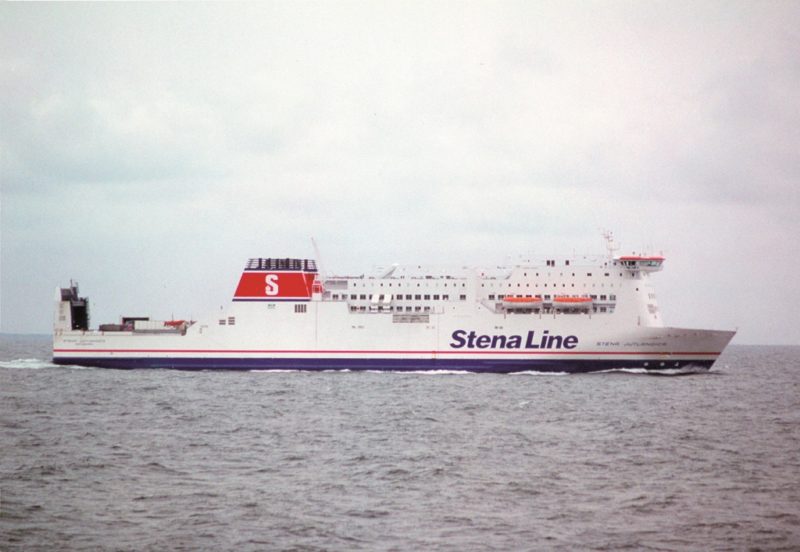
Stena Jutlandica collided with a tanker near Vinga in the Gothenburg archipelago on 19th July 2015, with a large hole torn in her hull of the ferry, which returned to Gothenburg under her own power and was sent to Odense for three weeks of repairs, no injuries were reported in the collision.
A joint venture was announced between the PCC car carrier and PCTC car and truck carrier Hyundai Glovis in February 2019, and was subsequently approved by the European Commission on Monopolies. This is for the implementation of a new jointly owned co-operative short sea Intra-European service for vehicles and cargo originating from South Korea and then for distribution around the ports of the North Sea and Baltic Sea. A new passenger and freight route was officially opened on 1st February 2020 between Halmstad and Grenaa to replace the existing Varberg to Grenaa route. Stena Nautica visited Varberg in Sweden for the last time on this day, and then berthed at the new Halmstad terminal on the same day.

On 14th March 2020, the serious outbreak of the Covid-19 virus forced Stena Line to suspend operations between Oslo and Frederikshavn with immediate effect until further notice due to travel restrictions in Denmark and Norway. The ferry Stena Saga (3) was sent to Gothenburg, where she arrived on 16th March 2020 for lay up, with Stena Line then making 950 redundancies as the service from Oslo to Frederikshavn was permanently closed three days later due to lack of profitability. This service was run six times per week, with a nine hours duration during daytime, and a longer 11 hours 45 minutes duration during a night crossing.
Stena Estrid of the new ‘E Flexer’ design of Ro-pax, runs on the Dublin to Cherbourg route. A total of nine ‘E-Flexers’ from Chinese yards will be delivered by the end of 2022, with five for Stena Line service, three for charter to Brittany Ferries for Spanish and French services, and one for charter to DFDS for its Dover to Calais service. The last group of ‘E-Flexers’ are larger than the first group of three, with accommodation for one thousand passengers and a lane length of 3,100 metres on their vehicle decks. Galicia, the first of the Brittany Ferries trio, was delivered on 3rd September 2020 on long term charter with the design of her interior public spaces and colour schemes chosen to reflect the region of Spain after which she was named.
Stena Transit and Stena Transporter make the night crossing from Killingholme to Hook in eleven hours with accommodation for 300 passengers, including two berth cabins for drivers together with their own restaurant. Hatche and POL Maris run on the Killingholme to Rotterdam service, and were built by Odense Staalskibsvarft A/S in 2009 and 2010 as Maas Viking for Norfolk Line and Wessex for UN Ro-Ro, and have been on charter to Stena Line from Alternative Transport A/S since 2020. They have a high lane length for freight of 3,663 metres and a high service speed of 21.5 knots from twin MaK diesel engines generating some 8,100 kilowatts of power. Urd and Stena Gothica will be replaced during 2021 on the Liepāja to Travemunde route by new ferries not yet named, with an increase of lane length for freight by 40%, and a shorter crossing of 20 hours compared to the original 27 hours.
Stena Germanica sailed from Kiel to Gothenburg on 21st December 2020 with a ‘knocked down’ crawler crane of 165 tonnes capacity. The project cargo was delivered to Kiel in 27 dismantled components, which were reloaded on to seven of Stena Line’s own tractors of 45 tonnes capacity. Project cargo can also be loaded at the Polish port of Gydnia, which operates a Ro-pax service to Karlskrona using Stena Vision and Stena Spirit, with Stena Nordica taking mostly freight.
The former Bornholm ferry Stena Vinga deputised for Stena Nautica on the Grenaa to Halmstad route for one month from end of February 2021 while Stena Nautica was absent on refit. Stena Vinga was built in 2005 and purchased in 2018 as Hamerodde from her route between Rønne on Bornholm and Koge near Copenhagen, and has accommodation for 400 passengers and space for 200 cars on her car deck.
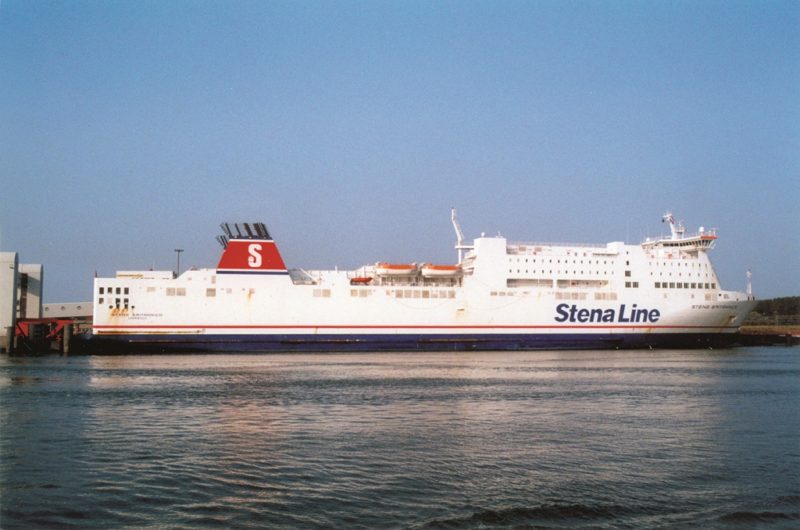
STENA BULK FAMILY of (MAX) TANKERS
The current Stena Bulk A/B tanker fleet is very large at 90 owned, chartered, managed and controlled tankers, of which 20 belong to the Stena Sonangol SUEZMAX pool of tankers of 160,000 dwt, three are Shuttle tankers in Stena Natalita, Stena Sirita and Stena Alexita, three are LNG gas tankers of 173,000 cubic metres capacity in Stena Clear Sky, Stena Blue Sky and Stena Crystal Sky, the AFRAMAX Stena Arctica and Stena Antarctica of 116,500 dwt for loading Russian oil cargoes, and 56 Medium Range (MR) tankers of between 50,000 dwt and 65,000 dwt. There are also five small tankers of between 9,600 dwt and 17,500 dwt, and two Methanol tankers of 49,900 dwt for delivery in 2022 as Stena Pro Patria and Stena Pro Mare.
The wide beam VLCC V-MAX and coastal C-MAX tankers were followed by a Medium Range (MR) group of tankers comprising ten P-MAX Ice Class 1B types of 49,000 dwt built in 2006/07 with twin funnels, twin rudders and twin engines in Croatia as Stena Paris, Stena Performance, Stena Perros, Stena President, Stena Progress, Stena Provence, Stena Primorsk, Stena Penguin, Stena Polaris and Stena Premium.
Stena Bulk A/B of Sweden in January 2011 acquired a 50% shareholding in Weco Shipping I/S, part of the Dannebrog Group. The Dannebrog dry cargo tramping fleet was founded in Denmark in 1883 with the Hansen family as manager. In 1967, Christian Kjellerup Hansen, Count Tido Wedell, and Baron Ebbe Wedell-Wedellsborg took over the management of the company, with Weco Shipping I/S appointed as managing owner. The Group structure in 1992 consisted of Weco-Rederi A/S, Weco-Shipping I/S, Weco-Transport I/S, and Dannebrog Rederi A/S. Weco Shipping I/S in 2011 was a market leader in the special products transportation of palm oils, edible oils, caustic soda and speciality chemicals. Golden Agri-Resorces (GAR) was founded in 1996 with all of its palm oil plantations in Indonesia, particularly Kalimantan (Borneo) and Sumatra. It had achieved an output of 2.911 million tonnes of palm products by 2012, and formed a global transportation agreement with Stena Weco A/S and Stena Bulk A/B to transport palm oil from its own jetties.
The tanker pool of Stena Weco A/S has offices in Copenhagen, Houston and Singapore and controls a very large fleet of 90 tankers. Many other Stena tankers including their ‘C’ class of 47,500 dwt operate in this very large pool of Medium Range and Handy Size product tankers to make it one of the leaders of this type of tanker operation in the world. Four Medium Range eco-type tankers were chartered in March 2015 from Aegean Shipping of Greece for the pool. Stena Bulk A/B and Stena Weco A/S also control fifteen tankers classed as IMOIIMAX types in Stena Impression, Stena Image, Stena Imperial, Stena Important, Stena Imperative, Stena Imagination, Stena Immortal, Stena Immaculate, Stena Impeccable, Stena Imperator, Stena Impero, Wisby Atlantic, Wisby Pacific and Stenaweco Impulse and Stenaweco Imprimis. Stenaweco Impulse was the tenth of the class to be delivered by the GS1 yard in China in 2017.
A further five MR types operate in the Stena-Weco joint operation as Stenaweco Energy, Stenaweco Evolution, Stenaweco Excellence, Stenaweco Elegance and Stenaweco Gladys W. All of the V-MAX, P-MAX, C-MAX and IMOIIMAX Stena tanker designs were innovatory, and won awards from their Classification Societies for their safety features. Stena Bulk A/B tankers frequently appear in the ‘Top Ten’ tankers in the world in their various classes.
The latest IMOIIMAX type of parcel chemical and product tankers carry IMO2 classed cargoes of clean or dirty products in 18 separate tanks, each of 3,000 square metres. The fuel consumption of the main engine has been cut by 10% to 20%, and with advanced loading, discharging and tank cleaning using nitrogen for safety, they are in demand to carry a large number of parcel tanker cargoes at the same time, including vegetable oils. They are of 50,000 dwt with dimensions of overall length of 183.2 metres, moulded beam of 32.3 metres. moulded depth of 18.2 metres, and a loaded draft of 11.0 metres. A future development of this design will be the IMOFLEXMAX design, which will reduce greenhouse gas emissions by over 25% compared to other modern product and chemical tankers owned by some other tanker operators. This reduction will come about by the use of tall Flettner rotors attached to the main deck of the tanker, the installation of solar panels, with new dual fuel engines able to run on LNG.

The Stena Bulk A/B tanker fleet is very much here to stay for the long haul, and this was demonstrated by the determination of Stena management during the long period of illegal capture of Stena Impero by Iranian naval forces in Omani territorial waters in the Gulf of Hormuz on 19th July 2019. The tanker and her crew of 23 were forcibly taken to Bandar Abbas in Iran and held hostage for over two months. The Master and crew were helped and supported by the Stena Bulk A/B Head Office on a day to day basis until they were finally released unharmed and arrived in Dubai at 0900 hours on 27th September 2019. The Master was awarded a Meritorious Service Medal for his exceptional leadership during this worst recent crisis of Stena Bulk A/B.
The delivery of a large semi-submersible drilling unit by Samsung Heavy Industries in South Korea, originally ordered on 26th June 2013 for delivery by 20th March 2016, was terminated on 1st June 2017 due to very excessive delays. The issue was taken by Samsung to a London Arbitration Tribunal, which found in March 2021 in favour of Stena and that the termination of contract was valid, and ordered immediate repayment of $411 million by Samsung to Stena of its pre-delivery payments.
Stena Drilling Ltd. currently own four sophisticated drillships and two drill rigs, the latter being the 3rd Generation Stena Spey of 1983 and a new 5th Generation rig built in 2001 as Stena Don, which is a twin pontoon column stabilised semi-submersible drill rig for water depths of 1,500 feet, with a maximum drill depth of 25,000 feet, and anchored by an eight point mooring system. The quartet of drillships entered service between 2008 and 2012 as the 6th Generation ‘Drillmax’ and ‘Icemax’ types Stena Drillmax, Stena Carron, Stena Forth and Stena Icemax. All four operate in harsh conditions with a double hull and winter protection of their drill equipment, a DP3 dynamically positioning system, and with many new drilling features e.g. for well centre transfers. They can drill in water depths of up to 10,000 feet, with a maximum drill depth through seawater of 35,000 feet.
SUMMARY OF STENA DIVISIONAL SUBSIDIARY COMPANIES
STENA LINE A/B
Annual transport of 7.5 million passengers, 1.7 million cars, and 2.1 million freight units on twenty routes throughout ten countries in Northern Europe, particularly in the three business areas of Scandinavia, North Sea and Irish Sea. Headquartered in Gothenburg. The fleet consists of 38 ferries serving twenty routes between ten countries in Northern Europe.
STENA RO-RO A/B
Owners of vessels for sale and particularly of charter of ro-paxes and ro-ros on any length of time period for mainstream passenger and freight use to worldwide ferry lines including Irish and French ferry lines, and to CMA CGM, MSC and other owners of container ships, or as accommodation and hotel ships for oil and industrial workers.
STENA BULK A/B
Ninety owned, chartered or managed tankers covering crude oil, refined products, chemicals, LPG and LNG gas, and methanol tankers.
STENA REDERI A/B
This company supports and co-ordinates the shipping activities of Stena.
STENA DRILLING Ltd.
Worldwide drilling in the North Sea, Mediterranean, Israel, Brazil, Peru, Guyana, with block bookings on exploration areas many years in advance. Two advanced drilling rigs, and four 6th generation drillships available. Based in Aberdeen.
STENA TEKNIK
Technical services to the oil industry, shipbuilding and shiprepair and conversion projects. The design of the battery powered Stena Elektra Ro-pax is one of their ongoing and most interesting projects.
STENA PROPERTY A/B
Formed in 1980 and now owner of 2.1 million square metres of office and private residential property, and manager of 300,000 square metres of real estate in Sweden, the Netherlands, France, China and the United States of America. One thousand apartments began to be constructed in 2012 in the Vegastaden district in the south of Stockholm, and in 2016 it acquired the six storey round ‘SCA House’ of offices on a long lease with over 25,000 square metres of office space.
STENA FINANCE A/B
This is the treasury and asset management entity for the whole of the Stena organisation, with control of the financial risks associated with shipping, oil and financial markets around the world. It is currently financing the building of nine large ships in China for the Stena fleet.
STENA ADACTUM A/B
This is the investment vehicle of the Stena organisation, and acquires and develops other companies with or without investments. It was established in Millennium year for long term investments in new business areas, and some of the current large investments are in the renewable energy and offshore wing farm (OWF) sectors.
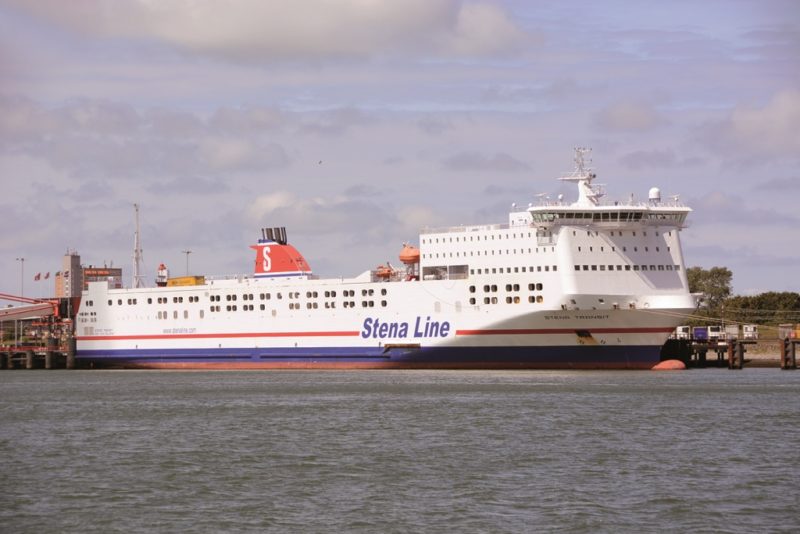
STENA METALL A/B
The death of Stena Metall A/B founder Sten Allan Olsson was announced on 12th July 2013 at the age of 96 years. Tributes were paid by all of the Stena senior directors and management, as well as ferry industry leaders throughout the world for his pioneering spirit in founding the many Stena businesses. The original Olsson business metals business area, which had grown into a major recycling company in Sweden for metals, paper, electronics, and hazardous waste, today also trades internationally in the recycling business. It now operates in Norway, Denmark, Finland, Poland, Russia, United States of America, Germany, Italy and Austria.
The Stena Sphere includes all of the activities of the three parent companies of Stena A/B of Sweden, Stena Sessan A/B of Sweden, and Stena Metall A/B of Sweden, which are wholly privately owned by the Olsson family as one of the largest family owned corporate groups in Sweden. The many other companies in the Stena Group are owned by a mixture of private and corporate share ownership. The Stena Group has made a profit in every trading year since 1939, a record that is difficult to match in the current largest shipping groups anywhere in the world. The liberal attitude to business affairs met its match in the failure of Stena BC Line in British Columbia in 1990, when it came up against the vociferous opposition by very hard core Native American shore based casinos, and the interests of the very large State owned fleet of Ro-paxes and Ro-Ros of the Alaskan Marine Highway (AMH). It is important to remember that the composition of both the ferry and tanker fleets change from year to year as vessels are both chartered in and chartered out of the fleets constantly. The total number of Stena ferries, tankers, offshore vessels and drillships remains steady however, at between 140 and 150 vessels.
The Stena Line ferry fleet has lost one route permanently closed as a result of the Covid-19 virus pandemic, although the Oslo to Frederikshavn route was closing anyway, with freight only on other routes e.g. passenger travel was banned between Sweden and Denmark from 20th December 2020. Freight only was running on the two routes from Gothenburg to Frederikshavn and Grenaa to Halmstad. There was a contraction in demand for passenger travel on al routes due to increased border closures. Stena Edda had all of her 322 passengers and 53 crew kept at her Birkenhead berth overnight on 16th December 2020 after six members of her crew tested positive for Covid-19 virus. Competitor DFDS reduced its ferry workforce by 650 in 2021, while Stena Line have opened new routes recently in the Baltic e.g. Liepāja (Latvia) to Travemunde in Germany with a stopover in Karlskrona in Sweden to hopefully bring the North European business and holiday travellers back to sail the Irish Sea, North Sea and most of the corners of the Baltic Sea on this great Stena Line fleet during the second half of 2021.
Stena Line are pleased to have joined forces with the Volvo Group and the Scania Group and the Port of Gothenburg to bring about a 70% reduction in greenhouse carbon emissions by the year 2030 in the Port of Gothenburg.
Gothenburg, (Göteborg) is the largest port in Sweden and celebrations for its 400th anniversary lasted throughout 2021. Stena Line are proud to display ‘Connecting Europe for a Sustainable Future’ on both side of the hulls of their Ro-pax and Ro-ro ferries as a very commendable green initiative. Strenuous efforts are being made by the Gothenburg City Council to improve the Masthuggkajen area of the city behind the big Stena Line ferry terminal.
The three masted replica of the Swedish East Indiaman Gotheborg, launched in 1738, whose seafarers all survived when the original ship sank off Gothenburg on 12th September 1745 on her return from her third voyage to China, will be a centrepiece of the revamped area with a visitor centre around the ship. The replica is of 788 grt and was built by the Terra Nova yard in Gothenburg, and made her first Baltic tour in 2008.

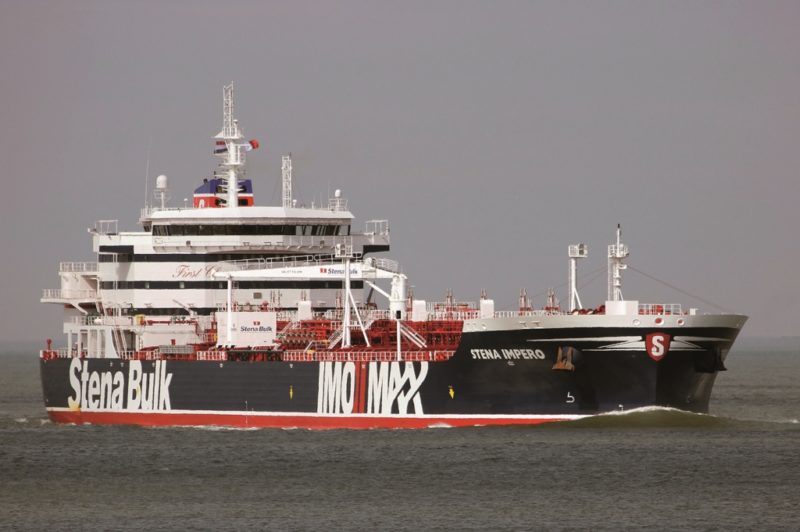
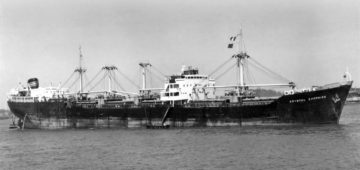


Comments
Sorry, comments are closed for this item